
Image 011202-01-01
Different variations of the 'S' mark were used from 1790 onwards, but no dates can be given.
In the year 1780 Christian Andreas Wilhelm Speck found out that the raw materials available in the area were not only suitable for manufacturing stoneware but also allowed the production of porcelain. Even after various fruitless efforts of trying to receive permission, he kept applying for a license to open business there for nearly ten years. Finally, on July 1st 1790, he was granted permission to build a factory by the Earl Carl Friedrich Reichsgraf zu Hatzfeld zu Gleichen.
The blue 'S' was used as first mark after production started the same year and in the year 1797, Christian Speck was present at the Leipzig fair for the first time. His products were an instant success, ensuring constant orders for the next few years. Nearly the whole factory was destroyed in a fire on June 26th 1817 and this resulted in a smaller output capacity and hindered industrial growth for quite some time. Christian Speck died at the age of nearly 70 years on December 30th, 1830.
Using the same marks as before, the new owner from 1830 onwards was Gustav Vogt, an advisor to the local chamber of commerce. But in 1840 the company was taken over yet again, this time by the businessman Sorge from the town of Auma and his partner Isidor Streithardt from the town of Uhlstädt. Things did not look so good until May 1841 when they were joined by H. Kästner who lived in Weimar and together they led the factory until 1848.
In 1848 the company was sold to the Fasold family who originally came from the city of Selb in Bavaria. They kept the business name until they joined up with Eichel in 1856 and from 1873 onwards, the whole factory was upgraded and soon included various new buildings which actually doubled its value. The shield of the Weimar dukes was finally adapted as trademark in 1887 and ten years later the factory even had its own electric power station. But shortly after that, the company dissolved as two of the Fasold family members died and Eichel proved unable to run the company alone, so the business was sold to Eduard Eichler who only owned it for a very short time before he himself changed his original business in Dux (today Duchcov) into a corporation. As the Blankenhain factory was now also part of the corporation, the name was also changed into Duxer Porzellanmanufaktur AG.
When the newly established Duxer Porzellanmanufaktur AG took over the porcelain factory in Blankenhain, the other Dux subsidiary in Šelty was liquidated; the corporation started to concentrate more on porcelain production as to replace the normal items produced until then. In 1900 the well known trade mark showing a pink coloured triangle with the inscription "Royal Dux Bohemia" was introduced and one should take note as this was not the only mark the company used during that period. In the Art Nouveau period the company achieved a most remarkable success thanks to its modeller Alois Hampel. The factory was also awarded the Grand Prix at the world exhibition in St. Louis in 1904, the silver medal at the exhibition in Milan (Italy) in 1906 and the gold medal at the exhibition in Liberec (Czech Republic) shortly afterwards; some of the products introduced at that time are still produced in Dux up to this day. This successful period was interrupted by WWI and because of the specific character of the produced goods, the pre-war standard of production could not be maintained, resulting in financial difficulties that in the end forced the Dux company to sell the Blankenhain subsidiary at the end of 1917.
The factory was taken over by the Hamburg based family Carstens in the same year, but the legal proceedings took until the following year before the name could be officially changed to Blankenhainer Porzellanfabrik C.&E. Carstens. After at first continuing to use the older mark, it was then changed in 1924 by adding the crown and laurel.
The Blankenhain business was one of the first companies in East Germany that was nationalized in 1948, even before the official founding of the German Democratic Republic in October 1949. The company was renamed to VEB Weimar Porzellan and from 1949 onwards (until 1980) the mark carried the addition 'MADE IN GDR'.
During the time from 1979 to 1984 the whole factory was modernized and some parts expanded further. A new production assembly with a capacity of 6,000 square meters was built and the traditional hand-fed and cleaned round kilns based on a 190 year old technology were replaced by a modern tunnel kiln with a lenght of 75 meters in the year 1981. In the meantime, the factory was declared part of the Feinkeramik Kahla combine in 1980 and the note "Made in GDR" was replaced by "Made in German Democractic Republic".
The highlights of production during the era of the German Democratic Republic were:
After German reunification in 1989/1990, Weimar Porzellan was integrated in the Treuhandanstalt program founded by the West German state.
Continuing a short time as a company under Treuhand leadership, the company found an investor and from January 1st 1992 onwards the Weimar Porzellan GmbH belonged to the real estate group Herbert Hillebrand Baubetreuungs- und Grundbesitz KG, which was based in Kerpen-Horrem and at that time also included:
But the grouping had its flaws and two of the three former East German companies had to close, forcing Herbert Hillebrand to file for bankruptcy as it had cost his group approximately 118 million Euro. Zeller Keramik and the Wallendorfer Porzellanmanufaktur were released out of the bankrupt group, but in April 1995 Weimar Porzellan had financial problems and had to file for bankrupcy.
The city of Blankenhain, together with British American Ltd. and Optima Immobilien GmbH acquired shares of Weimar Porzellan and managed to re-establish basic functionality on June 1st 1995. An intensive restructuring program was initiated, including the reduction of the production area from a four-floored building with 30,000 square meters down to a ground-level building with 9,000 square meters. Investments regarding the productivity and quality were made, including new firing and glazing kilns worth 1,3 million Euro. In 1997 the newly constructed decorating section including the new decoration/glazing kiln was put into service, drastically cutting energy costs and maximizing production flexibility.
British American Ltd. and Optima Immobilien GmbH late in 1995/early 1996 sold their investments to three senior company executives which then held 51% of shares whereas the city of Blankenhain held the remaining 49%. In July 1998 the company opened a special event sales and factory outlet area with 400 square meters and also started to offer guided tours and decoration classes. This feature was not only of special interest for tourists and in 1999 the special event and factory outlet area grew to a size of 600 square meters and a second firing/glazing kiln was taken into service. All together the investments made since 1995 added up to a value of over three million Euro.
The rough ride was long from over, though. In 2006 Weimar Porzellan was again taken over, this time by Herbert Hillebrand relatives in form of the Geschwister Hillebrand GmbH. Under managing director Katharina Hillebrand the three senior company executives mentioned before remained in office.
In January 2007 Weimar Porzellan was purchased by Könitz Porzellan which was owned and operated by Turpin Rosenthal, member of the famous porelain manufacturer family. Due to the massive changes on the German porcelain market the business however necer stood a real chance and so it in 2018 had yet again file for insolvency proceedings. All business anded on December 31st the same year; mark and brand rights were taken over by the KARACA Porzellan Deutschland GmbH.
The items made for Wheelock are normally clearly marked, as can be seen below. Another example would be "Wheelock", "Made in Germany", "for Bayles the Jeweler", "Chillicote, Ill." and "Weimar".

Image 011202-01-01
Different variations of the 'S' mark were used from 1790 onwards, but no dates can be given.

Image 011202-01-02
Used after 1790, second example.

Image 011202-01-03
Used after 1790, third example.

Image 011202-01-04
Used after 1790, fourth example.
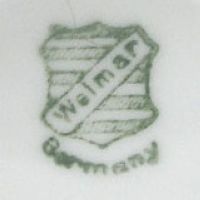
Image 011202-02-01
Used from around 1905 onwards, the shield of the Weimar dukes. Minor changes were made over the time, this is one with small "Germany".
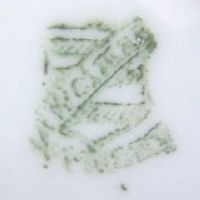
Image 011202-02-02
Marks were not always perfect as can be seen when looking at this example.
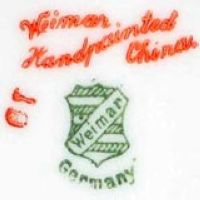
Image 011202-02-03
Here an example with the hard to find "Weimar Handpainted China" addition in red.
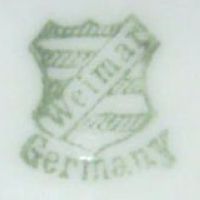
Image 011202-02-04
Another version of the shield mark, here with large "Germany". That addition was not always used ...

Image 011202-02-05
... for example it was never used under this version with filled horizontal bars (drawn example).
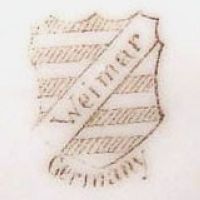
Image 011202-02-06
The finer painted shield is found on younger items (here including "Germany") ...
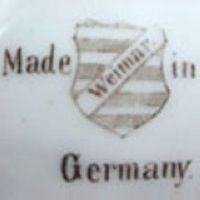
Image 011202-02-07
... and some of these are surrounded by "Made in Germany".
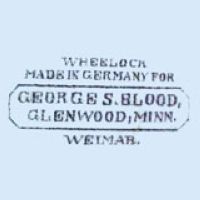
Image 011202-02/03-01
Items made for US retailer Wheelock received own marks like this one.
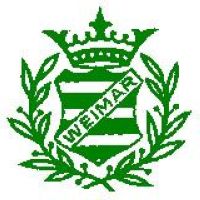
Image 011202-04-01
1924 the mark was changed again by adding the crown and laurel, resulting in the mark shown here which was used in green and blue under glaze.
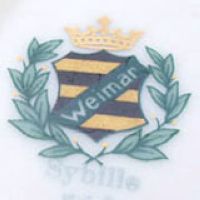
Image 011202-04-02
The mark was also used in a colored version like this.
(Picture: Michael Payne)
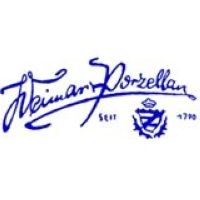
Image 011202-04-03
This blue mark seems to have been used from 1928 until 1960, used on products with small bases were the bigger mark did not fit.
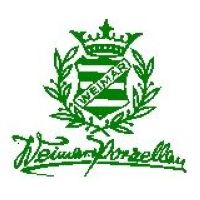
Image 011202-05-01
1948 the mark was altered and now carried the addition "Weimar Porzellan" as shown here.
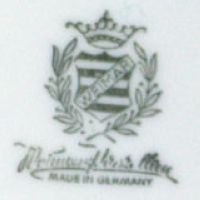
Image 011202-05-02
This one was in use only shortly after the founding of the GDR, note the "Made in Germany".
(Picture: Jacqueline Kacprzak)
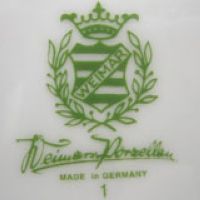
Image 011202-05-03
Another example in bright green.
(Picture: Thomas Menz)
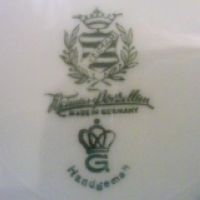
Image 011202-05-04
Here a version with "Made in Germany" and a (so far) unidentified third party addition.
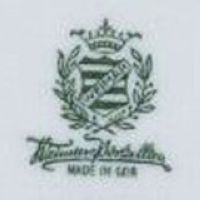
Image 011202-05-05
In 1949 the note "Made in GDR" was added and used until 1980.
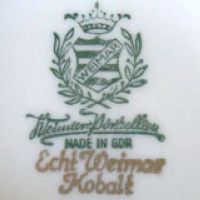
Image 011202-05-06
Same as before, this time with the "Echt Weimar Kobalt" addition in gold lettering.
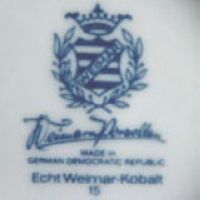
Image 011202-05-07
1980 then saw the introduction of the "Made in German Democratic Republic" addition.
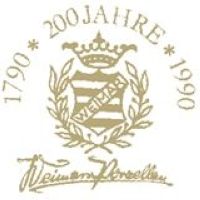
Image 011202-06-01
This mark was used on all pieces to celebrate the 200 year production aniversary in 1990.
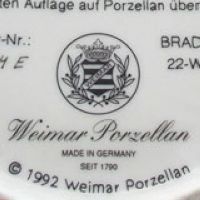
Image 011202-06-02
This one is from a 1992 limited edition plate.
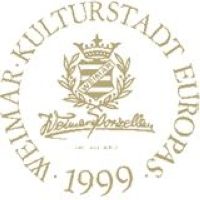
Image 011202-06-03
Used to celebrate the status of the city of Weimar as Cultural City of Europe in 1999. Can only be found on the "Weimar Classics 99' Limited Edition".
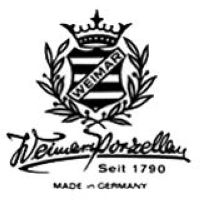
Image 011202-06-04
The currently used mark.
© 2004-2025 C.S.Marshall, all rights reserved